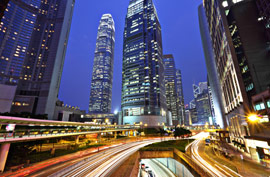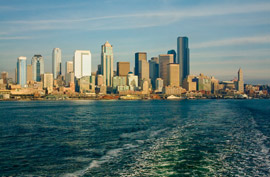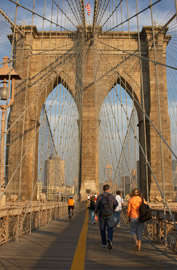 Any visit to a new city is defined -- and driven -- by a long list of do's. Most likely, you will want to do the museums, do a few tours, do dinner and drinks, basically do everything you possibly can before the vacation clock runs out. To paraphrase a popular saying: You can do nothing when you're back home.
Any visit to a new city is defined -- and driven -- by a long list of do's. Most likely, you will want to do the museums, do a few tours, do dinner and drinks, basically do everything you possibly can before the vacation clock runs out. To paraphrase a popular saying: You can do nothing when you're back home.
Sometimes, though, you need to slip a don't into your trip, just to keep you safe and savvy.
Despite the adverse ring to the word, our tips aren't limiting or nagging. Quite the contrary. Our five suggestions -- part insider information, part concerned parent -- will make you a smarter urbanite capable of navigating virgin territory like a seasoned pro. Most importantly, our guiding light of don'ts will expand your list of gotta-do's.
1. Don't Always PayCities, especially the most expensive ones (think Oslo, Geneva, Zurich, Copenhagen, Stockholm ...), inhale your money like a vacuum cleaner set on high. To protect your money purse, take advantage of a destination's more giving side. (Read: Free attractions.)
Gratis activities are ubiquitous if you know where to look. Flea, antique and farmers' markets are often free for idle wanderers, as are many art galleries, outdoor festivals and parks -- such as Tiergarten in Berlin and San Francisco's Golden Gate National Recreation Area, for instance. Most cities offer a handful of museums and monuments that don't charge admission. In Washington D.C., the Smithsonian museums and national memorials don't want your money. Ditto for the Getty Center in Los Angeles and the Victoria and Albert Museum in London.
 25 Ways to Save Money in Europe
25 Ways to Save Money in Europe
Many institutions that do exact a fee will set aside complimentary days or hours. New York's Museum of Modern Art waives the charge Fridays from 4 to 8 p.m.; at the Louvre in Paris, visitors can hang onto their euros the first Sunday of each month from October through March. Guests under age 26 also enter for free on Fridays from 6 to 9:45 p.m.
If you are a student, teacher, senior or member of the military, always carry ID; freebies or discounts may drop into your lap.
To further treat your wallet to a break, snag free audience tickets to a TV show taping -- "The View," "The Daily Show," "The Price Is Right" -- in New York or Los Angeles. For the game show, you might even return home with a tidy profit. Or tag along on a free tour, such as Free Tours by Foot, which operates "pay what you wish" excursions in several cities including London, Paris and Washington D.C. (Keep in mind that tips are often appreciated even if the tour itself is free.)
For events and attractions of this ilk, check the websites of city tourism offices as well as such gadabout publications as Time Out. Alternative newsweeklies also list events that cater to penniless artists and students. For techie travelers, many smartphone apps highlight gratis diversions, such as the "Top 25 San Francisco Attractions Guide & Free Things To Do" (available for iPhones and iPads). If the app itself is free, all the better.
2. Don't Hail a CabIt's so easy to snag a cab: Wag a hand, and seconds later a blur of yellow will screech to a stop. However, moving around a city in a taxi can be costly and, frankly, hair-raising. For a more local experience and a potentially quicker pony ride (especially at rush hour), take public transportation.
In New York or Beijing, hop on the subway; in Boston, the T; in Chicago, the L; in Washington, Los Angeles and Paris, the Metro; in London, the iconic Tube. If you plan to bounce all over the place, purchase an all-day or multi-day pass.
 Another fanciful way to travel is to make like Cap'n Crunch and hit the water. In New York City, ferries ply the Hudson and East rivers. The boats pick up and drop off seaworthy passengers in Brooklyn, Queens, Wall Street, Midtown East and West, and New Jersey, depending on the body of water. You can also travel via liquid highway in Amsterdam and Boston. (Venice, of course, goes without saying.)
Another fanciful way to travel is to make like Cap'n Crunch and hit the water. In New York City, ferries ply the Hudson and East rivers. The boats pick up and drop off seaworthy passengers in Brooklyn, Queens, Wall Street, Midtown East and West, and New Jersey, depending on the body of water. You can also travel via liquid highway in Amsterdam and Boston. (Venice, of course, goes without saying.)
If you're looking for an adrenaline rush, strap yourself into a pedi-cab. The bike-drawn carriages, now available in many major urban centers around the world, have all the guts and gumption of bike couriers -- but with more comfortable seating. Warning: Keep your hands inside the vehicle or you could end up banging them on a stop sign or passing cow.
When traveling to/from the airport, just say no to the cabbie. There are quicker and cheaper alternatives that don't require the unnerving Meter Watch. Trains, buses and/or shared shuttles link most major airports with the nearest downtown area.
 Find Cheap Airfares to Cities Around the World
Find Cheap Airfares to Cities Around the World
Metropolitan centers are packed with millions of residents and many more millions of tourists, so it's no wonder that shows sell out and restaurants fill up. While some activities (stand-by theater tickets, for one) thrive in the last-minute rush, many events require a touch of pre-planning.
Numerous publications and official organizations promote activities far in advance, so that you can arrange accordingly. Check the calendars posted by tourism offices, cultural organizations, and in-the-know media outlets such as LA Weekly, the Village Voice, Time Out London, the Japan Times, etc. If you have specific interests in mind, go directly to that source, such as individual theaters for performing arts, Open Table for dining reservations or stadiums for sporting events.
4. Don't Forget Your MapMothers and cops know best: For safety's sake, familiarize yourself with your surroundings. You can avoid unsavory situations by returning to the timeless tradition of carrying a map.
The navigational tool will help you understand how the neighborhoods line up and prevent you from straying into shadowy areas. Pick up a map (standalone or in a guidebook) or a smartphone app that covers the entire metro area, plus outtakes of specific neighborhoods. The built-in iPhone map is handy when traveling within your own country, though to avoid roaming charges in international destinations, you may need to spring for an app.
Additionally, tourism offices typically provide printable maps on their websites. Most tourist centers and hotels also stock free maps for the taking.
 How to Create the Perfect Itinerary
How to Create the Perfect Itinerary
Don't just spin circles inside the city center; break out and dance along the edges. In a city's suburbs and outer boroughs, you will stumble upon scenes that are often a dab more authentic, experimental or exotic.
For example, Dearborn, in the Detroit metro area, contains the Henry Ford Museum and factory tour as well as a sizable Arab-American community that is well represented by the Arab American National Museum and a slew of Middle Eastern eateries. Neuilly, which borders Paris, is a wealthy enclave of boutiques, cafes, street markets and the 18th-century Chateau de Neuilly, now a lush park. Tokyo's suburbs are sprinkled with shrines and temples, beaches and hiking trails.
 You'd be remiss, and kicking yourself, for skipping the other boroughs of New York City outside of Manhattan. Brooklyn, for instance, is the dark prince of avant-garde arts and eats, particularly in the neighborhoods of DUMBO, Williamsburg and Bushwick. Queens is a world map of cultures, with nearly half the population foreign-born. (For example, one of the largest Greek populations outside of Greece lives in Astoria, which means lots of moussaka and tzatziki.) The Bronx has the famous zoo (one that features animals, another populated by wild Yankees fans), plus loads of green space (manicured and untamed) and blue expanses (the waterfront City Island).
You'd be remiss, and kicking yourself, for skipping the other boroughs of New York City outside of Manhattan. Brooklyn, for instance, is the dark prince of avant-garde arts and eats, particularly in the neighborhoods of DUMBO, Williamsburg and Bushwick. Queens is a world map of cultures, with nearly half the population foreign-born. (For example, one of the largest Greek populations outside of Greece lives in Astoria, which means lots of moussaka and tzatziki.) The Bronx has the famous zoo (one that features animals, another populated by wild Yankees fans), plus loads of green space (manicured and untamed) and blue expanses (the waterfront City Island).
For more inspirations, peruse the "Not For Tourists" guidebook series, which covers the trodden and less-trodden parts of select cities, including Amsterdam, New Orleans and Paris. Or ask the first hip locals you see where they live and then secretly tail them.